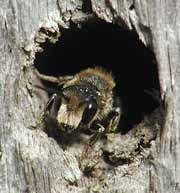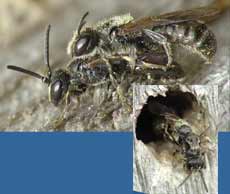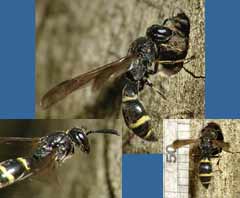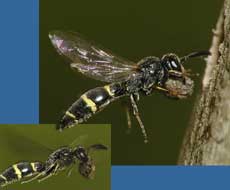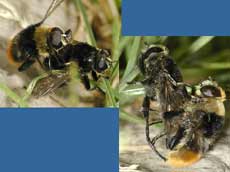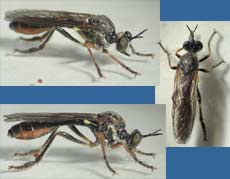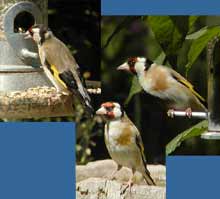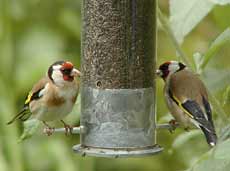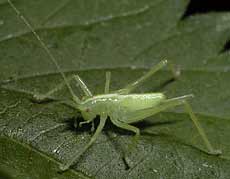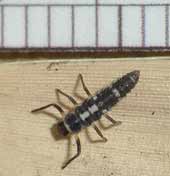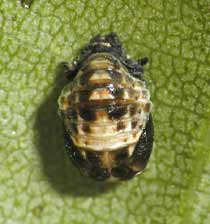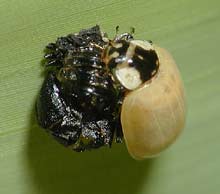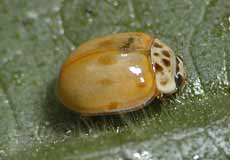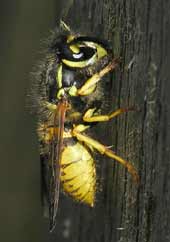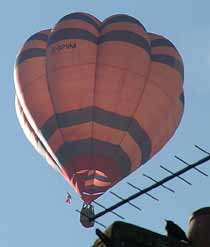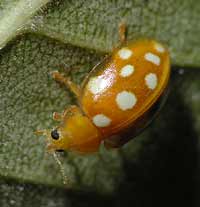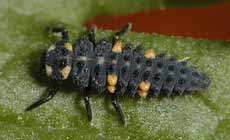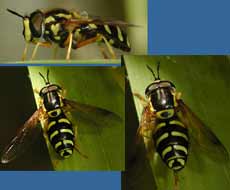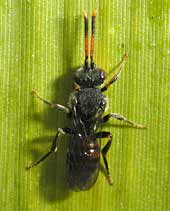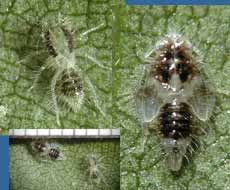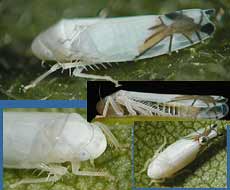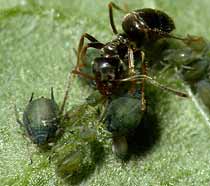Go to last entry on the page......................Go to previous entry
The way it holds its abdomen as it flies towards the hole makes it clearly different to the other visitors.
13 June - A very warm, sunny day but I have got very little done - holidays are hard work! It is going to be a couple more days before things get back to normal.
This character was just leaving one of the larger, 7mm holes, and
this smaller bee was looking out of a slightly narrower, 6mm hole.
There are quite a few of these tiny bees using 3mm holes. This mating pair were photographed yesterday, wandering around on the vertical front of the timber and going in and out of empty holes.
At the bottom of the garden there is a log that is used a stool. This morning I spotted this wasp going into a natural hole in the wood. I wasn't able to keep watching so I didn't see what prey it took in as a food supply for its larvae and when I did get to take photographs it was already sealing the hole, which measures 4mm across.
This evening I have drilled some more holes of the same size in the hope that I can get more photo opportunities tomorrow. I have already seen the wasp going into one of them. A frustrating moment occurred while I was taking these photographs. The camera was mounted on a small tripod and as I waited for the wasp to return another solitary wasp ran across the paving in front of me, carrying a garden spider that was bigger than the wasp. Although I was able to get my camera off the tripod quickly, the wasp was even quicker and disappeared up a climbing plant. 14 June - The warm weather continues and I continue to do very little!
You can see how its legs are tucked up against the body until just before it lands, when its front two pairs of legs are brought forward to grab the wood around the hole entrance.
A search through a guide to solitary wasps suggests that it is Symmorphus bifasciatus which hunts the larvae of leaf beetles.
A loud buzzing attracted my attention to the ground at the side of the path. There I found this pair of hoverflies mating. I think they are Narcissus-flies, but my insect guide doesn't mention the female being all black in colour.
This fly appeared on window in the house. It's a true fly, with just one pair of wings and a pair of stabilising haltares, which are bright yellow. Nigel Jones (no relation) of
www.insectpix.net Robberflies are predatory flies that catch other insects in mid-air, often waiting on a plant to ambush their prey.
It's about time I mentioned the birds, or rather lack of birds in the garden. In our absence they seem to have deserted the place. The Blue Tits have obviously fledged and the Collared Dove nest is empty. Replenishing the feeders has started to bring back the sparrows but otherwise other visitors are few and far between so far.
15 June - The dry, very warm weather continues.
A look at the half empty feeder suggests that they have been here a number of times over the last few weeks. It has been in place since last year with hardly a visitor so this is a bit of great news. I've topped up the feeder and we have our fingers crossed that the Goldfinches will bring a few friends next time! No photograph to show for another observation today. Sheila and I were having lunch at the bottom of the garden when a very large ichneumon fly turned up and spent time inspecting the log in which our solitary wasp is egg laying. Although it didn't land, its size, along with the extremely long ovipositor meant that the nearest we could get to matching it in the insect guide book was Agriottypus sp. It didn't stay long enough for me to get my camera.
While we are beginning to see birds coming back to feed, the only juvenile I've seen so far has been a young Starling.
I hadn't mentioned it previously but I have been disappointed by my failure to spot any Bush Crickets in the garden so far this month. Last year they appeared late in May, on the Geraniums below the Birch tree. Well, last night I saw two quite large, although still immature crickets, this one on a Stinging Nettle leaf, and a second one on the underside of a Birch leaf.
There are not a lot of adult ladybirds about so far but I have seen numerous larvae, often dashing about on the ground, surprisingly. I spotted this larva moving very quickly across the paving stones while we were having coffee. It paused long enough on dead bamboo leaf for me to get this one (slightly out of focus!) image. It appears to be the larva of a 14-spot ladybird.
There are numerous ladybird pupae on the bamboo plants, most looking like this one.
This morning I spotted(!) this ladybird that had just emerged for such a pupa. Although the elytra is still pale and spotless, the large white spots at the sides of the thorax suggest that it is a 2-spot ladybird. I'm afraid the picture is a bit blurred as the leaf was being moved by the breeze.
This ladybird was on the Stinging Nettles. I have had a bit of a problem with this one. The nearest match I can come up with is that it could be an immature 10-spot Ladybird.
I do not know what laid them, but there are several clumps of eggs like this one on the underside of leaves on the Birch tree. I suspect that they could be ladybird eggs, hopefully the Orange Ladybird.
The solitary wasp photographed over the last few days continues to work at the same set of holes. It has now sealed four of them and was going into a fifth this evening. At the bee hotel I have spotted a different species of solitary wasp and I shall be watching for it again in the morning. Bee activity there continues to be pretty hectic while the sun shines on them, but once they were in the shade it all goes quiet.
The timber support that the bee hotels are attached to is untreated wood, and this evening it had a visit from this social wasp, scraping wood fibres from the surface to use in the construction of cells in its nest. If you look carefully at the wood surface you can see the smooth area compared with the rough texture in the foreground. This is one of just a few social wasps that I have seen so far this year.
However, this morning has started with blue skies and a rather large visitor (well, nearly!) in the form of this hot-air balloon. We usually see them to the South of us, but this one arrived from the North, being swept past us at a good speed - I trust it will slow down before it has to land. I couldn't resist capturing the moment when it crossed the tv antenna, a favourite perch for birds such as the Starling that seems to be watching the balloon form the chimney top.
Another surprise met me when I took my usual late trip down the garden with a torch last night. I counted seven of them, all very active, scurrying around on the leaves and branches of the Birch tree, their usual haunt. This is, I think, the earliest I have seen them here. It's usually the end of summer that I start to see their activities. I am beginning to wonder whether the eggs I photographed three days ago were laid by them. They show no sign yet of hatching out so I shall have to keep a careful watch over them. There was no sign of the adults this morning.
In my previous entry I mentioned seeing ladybird larvae on the ground. Yesterday I had to to some metalwork under the caravan shelter, and several times I saw larvae like this one dashing across the concrete floor. I had to rescue this one that ventured perilously close to where I was using a blow-torch. I think it is the larva of a 7-spot Ladybird.
At the end of March I scattered a couple of packets of wild flower seeds onto the small area in front of my workshop shed. Amongst them were poppy seeds and at last the first poppy flower had opened. Hopefully some more flowers will appear in the days to come. Although I haven't photographed them we also have several foxgloves which have been in flower for several weeks, stating soon after we left for our holiday.
There were Long-tailed Tits about today and the adults were collecting food for at least one youngster that spent time calling from the conifers behind the garden. This poor image was the best I managed to get as it flitted between branches, calling for food as an adult worked its way around my neighbour's apple tree.
We were having coffee down the West Wing when the Long-tailed Tits were about, but they were not the only things to distract me from the drink. I spotted what I thought was a boldly marked hoverfly on a bamboo plant. Looking through my guide books has made me think again. Although I can't match it, I now suspect that it is one of a group of insects called Soldier flies. I should have stayed with my first thought - it's a hoverfly after all - a Chrysotoxum sp., probably Chrysotoxum festivum.
A couple more unidentified beasts also made an appearance. This one stayed just long enough on the bamboo for me to take one shot of it.
This one is a nymph that seems to have just moulted, and its cast exoskeleton is on the right, with both shown next to a mm scale in the small image. They are on the underside of a Birch leaf.
21 June - Over the last few days the weather has turned quite autumnal. The daytime temperatures have dropped into the teens, but so far we have not had more than the odd drop of rain. The forecast suggests that that will change in the next day or so, with heavy rain heading our way.
Like the nymphs, these will move about quite quickly on the leaves, often almost sideways, crab-like. They react to any movement near them by heading for the other side of the leaf. One flew off as I handled the leaves.
I can't be sure that they came from the nymphs, but there were no other insects near by, other than a solitary mirid bug which I didn't photograph! I wonder whether they loose the whiteness as time goes on. The large number of spines on the hind leg indicated that this is a leafhopper, and it has since been suggested that it is probably a species called Eupteryx stellulata.
While on the topic of smaller inhabitants of the garden, there are quite a few Black Bean Aphids (Blackfly) about at the moment. While they are regarded as pests, it's fascinating to see how the ants are taking full advantage of their numbers, herding them into groups, collecting the honeydew they produce, and protecting them from predators.
|
|


